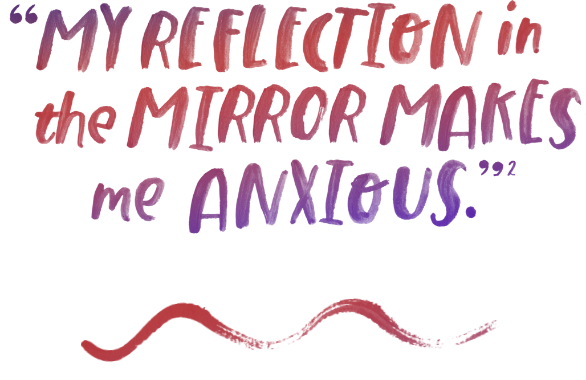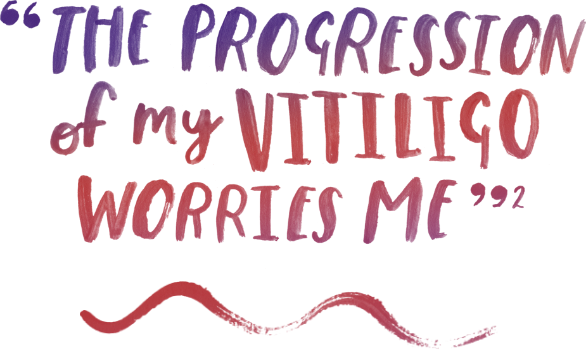Vitiligo may be a visible autoimmune disease, but you will know from discussions with your patients that the psychosocial impact can be significant.
Of patients report vitiligo affects their confidence1
Of patients worry their condition will get worse2
Patients are five times more likely to have depression compared to healthy individuals3
Understanding the comorbidities of vitiligo
You may have observed that your patients with vitiligo often have other comorbidities,
in fact, the most common of which is hypothyroidism which impacts approximately 1 in 10 people living with the condition.6
Autoimmune diseases associated with vitiligo6

Image adapted from Hadi et al 2020.

Image adapted from Hadi et al 2020.
How does vitiligo impact quality of life?
Many of your patients’ quality of life may be impacted through being diagnosed with vitiligo. The extent of the disease, site of skin lesions and the age of the patient all contribute to an impaired quality of life.1,2 Not only does vitiligo cause psychosocial burdens such as low self-esteem, it is also associated with other autoimmune comorbidities such as hypothyroidism.6,7
Impact of disease extent
Quality of life was found to be impacted in notable ways for patients living with vitiligo. 50-81% of patients said that their quality of life was impacted, regardless of the precise location of their vitiligo.8
- Approximately 1 in 2 patients said their vitiligo influenced their career choice1
- Approximately 1 in 2 believe vitiligo has slowed their career progress1
- Approximately 1 in 2 said their vitiligo impacted their decision to attend work or school1
About 45% of people living with vitiligo also said that their condition had an effect on their daily activities such as visiting the hairdresser, exercising, or being intimate with their partner.1 Mental health conditions are also significant among those affected by vitiligo — in Europe, half of patients have symptoms consistent with moderate to severe depression.1

Adapted from Bae JM et al. Br J Dermatol (2018)
Impact of lesion location and distribution
The precise location of lesions and their extent may also determine how much a patient’s quality of life can be affected by vitiligo8. Patients with visible lesions, such as on the face and hands, were more likely to experience depressive symptoms compared to those with lesions on non-visible areas of the body.9 In Europe, 45% of patients have lesions which cover ≥5% of their total body surface area.10
The impending spread of these vitiligo lesions is also a constant concern, with approximately 2 in 3 of patients saying their vitiligo spreads more quickly following periods of stress.10 Stress-related flare-ups were even more frequent in individuals with higher body surface area involvement, such as those with darker skin types or facial lesions.10
The impact of skin tone
Skin tone is also a significant factor in how vitiligo impairs quality of life.1 In patients with darker skin tones, in whom the lesions are more evident, higher impact on their life has been reported compared to those with lighter skin tones.11 Over a third of patients globally said that their vitiligo made them feel disconnected from their cultural heritage.1
VALIANT – a global patient study
VALIANT was a study sponsored by Incyte that evaluated the impact of vitiligo on the daily lives of patients, from the perspectives of both patients and HCPs. The study was carried out through an online survey completed by 3,541 people with vitiligo aged 18+ (including 1,151 European patients).1
Vitiligo has a high disease burden
Vitiligo has a huge impact on patient lives, in many more ways than you may think. The study found that even in picking out an outfit for the day, 55% of patients had to consider their vitiligo.1 This means that every day, patients are reminded of their condition and the ways it limits their lives.
Vitiligo has a negative effect on people's work life or education
More than 47% of patients with vitiligo stated that it had impacted their attendance in the workplace or in school1
On average, patients have tried 6 treatments for their vitiligo
Globally, people living with vitiligo will try half a dozen treatments for their condition. However, in Europe, 17% of patients are not receiving treatment.10
Vitiligo is forcing people to miss out on a social life
Around 42% of patients reported becoming withdrawn due to their vitiligo1
- Bibeau K, Hamzavi I, et al. Mental Health and Psychosocial Burden Among Patients Living With Vitiligo: Findings From the Global VALIANT Study. Presented at: Maui Derm for Dermatologists; January 24, 2022; Grand Wailea, Maui, HI.
- Bae JM, Lee SC, et al. Factors Affecting Quality of Life in Patients With Vitiligo: A Nationwide Study. Br J Dermatol. 2018;178(1):238-244.
- Wang G, Qiu D, et al. The Prevalence and Odds of Depression in Patients With Vitiligo: A Meta-Analysis. J Eur Acad Dermatol Venereol. 2018;32(8):1343-1351.
- Ezzedine K, Eleftheriadou V, et al. Psychosocial Effects of Vitiligo: A Systematic Literature Review. Am J Clin Dermatol. 2021;22(6):757-774.
- Radtke MA, Schäfer I, et al. Willingness-to-Pay and Quality of Life in Patients With Vitiligo. Br J Dermatol. 2009;161(1):134-139.
- Hadi A, Wang JF, et al. Comorbid Diseases of Vitiligo: A 10-Tear Cross-Sectional Retrospective Study of an Urban US Population. J Am Acad Dermatol. 2020;82(3):628-633.
- Kirpal’s story: What makes you different makes you beautiful. Published Winter 2020. Accessed August 2022. https://www.changingfaces.org.uk/story/kirpals-story-what-makes-you-different-makes-you-beautiful/.
- Silverberg JI, Silverberg NB. Association Between Vitiligo Extent and Distribution and Quality-of-Life Impairment. JAMA Dermatol. 2013;149(2):159-164.
- Grimes PE, Miller MM. Vitiligo: Patient Stories, Self-Esteem, and the Psychological Burden of Disease Int J Womens Dermatol. 2018;4(1):32-37.
- Bibeau K, Parsad D, et al. Exploring the Natural and Treatment History of Vitiligo: Findings From the Global VALIANT Study. Presented at: Maui Derm for Dermatologists; January 24, 2022; Grand Wailea, Maui, HI.
- Le Poole IC, Mehrotra S. Replenishing Regulatory T Cells to Halt Depigmentation in Vitiligo. J Investig Dermatol Symp Proc. 2017;18(2):S38-S45.








